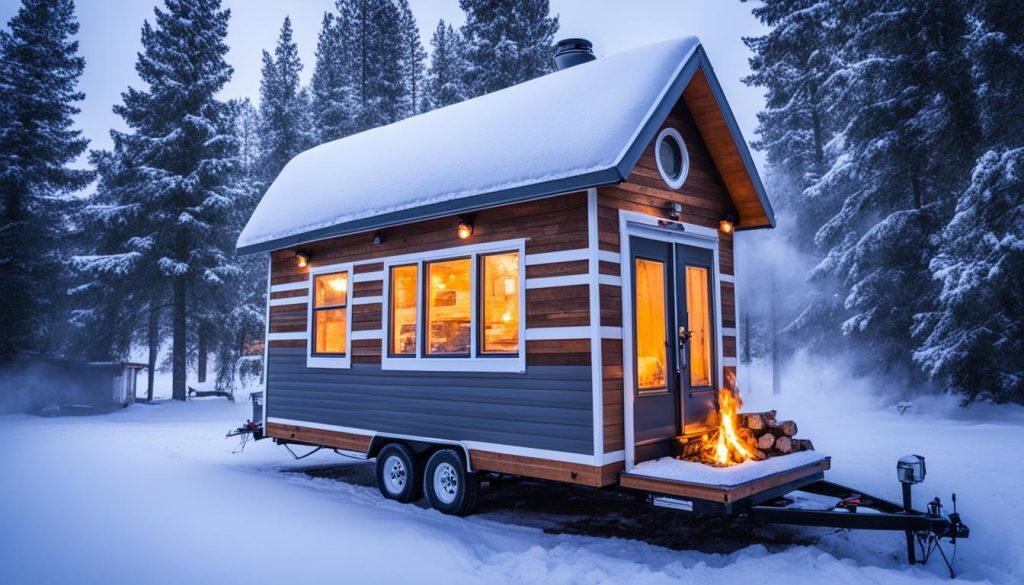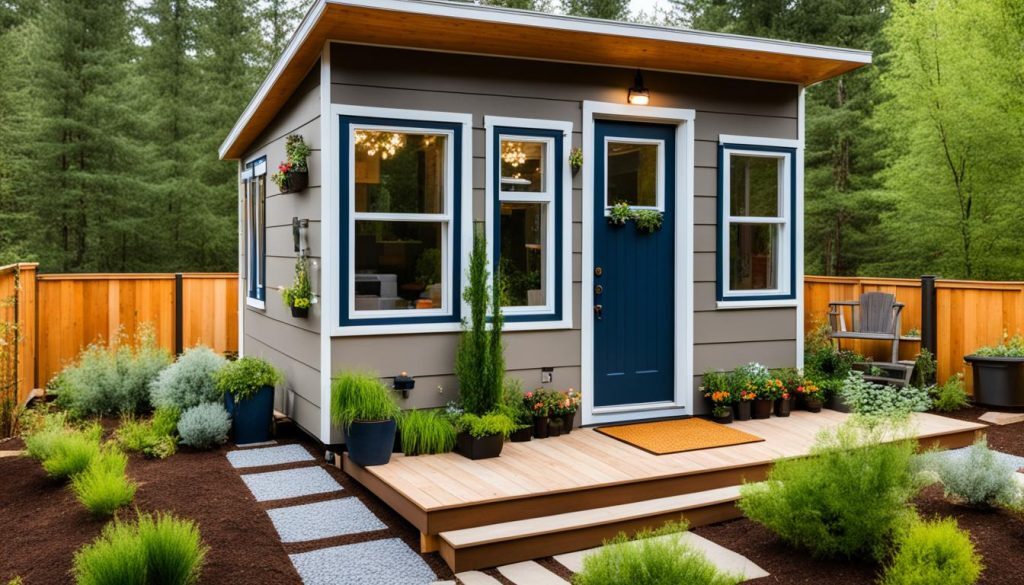Did you know that the demand for tiny homes has skyrocketed in recent years? In fact, the tiny house movement is gaining traction across Canada, with more and more people opting for these pint-sized dwellings as a way to achieve affordable and sustainable living.
But before you jump on the tiny house bandwagon, it’s important to understand the legal aspects surrounding them. While these mini abodes may seem like an ideal solution, there are specific rules and regulations that dictate where you can build or park one.
Key Takeaways:
- Understanding the legality of tiny homes is crucial before embarking on your tiny living journey.
- Tiny homes are a popular choice for eco-conscious individuals looking for affordable and sustainable housing options.
- Each province and municipality in Canada has its own set of rules and building codes regarding tiny homes.
- It’s important to research and comply with the local regulations and restrictions before starting your tiny home project.
- Consulting with certified tiny home builders can help ensure your tiny home meets all legal requirements.
Are Tiny Homes Legal in Ontario?
In Ontario, tiny homes are legal as long as they adhere to specific rules and regulations. The province has set guidelines to ensure safety and compliance with the Ontario Building Code. If you are considering building or owning a tiny home in Ontario, it is crucial to understand the legal requirements and follow the necessary procedures.
The primary rule for tiny homes in Ontario is that they must have a minimum total square footage of 188 square feet. This size requirement ensures that the dwelling is habitable and provides enough space for basic amenities and living necessities.
Additionally, compliance with the Ontario Building Code is essential. The building code sets standards for construction, including structural integrity, electrical systems, plumbing, and fire safety measures. Adhering to these regulations helps ensure the safety and well-being of occupants.
It’s important to note that regulations may differ for tiny homes on wheels compared to those built on a foundation. Some municipalities in Ontario may have specific rules prohibiting or restricting tiny homes on wheels, while others may allow them with certain conditions. Consulting local by-laws and zoning regulations is crucial to determine if your desired location permits tiny homes on wheels.
For those interested in purchasing a certified tiny home, there are reputable builders in Ontario who offer pre-inspected and pre-certified homes. These builders have expertise in constructing tiny homes that meet all legal requirements, making the process easier and ensuring compliance. Working with certified builders can provide peace of mind and assurance that your tiny home meets the necessary standards.
While tiny homes offer an alternative and sustainable housing solution, it’s important to navigate the legal landscape to ensure your tiny home is legal in Ontario. By following the proper rules and regulations, you can enjoy the benefits of living in a tiny home while staying within the boundaries of the law.
Where Can You Put a Tiny Home in Ontario?
When it comes to finding a location for your tiny home in Ontario, there are several options available to you. Whether you own an empty lot, have some space in your backyard, or prefer to live in a tiny home community, Ontario offers various permissible locations for tiny homes.
If you own an empty lot, you have the freedom to place your tiny home wherever you like, as long as it complies with building codes and local by-laws. This option provides you with the flexibility to design and customize your own space according to your preferences.
Alternatively, if you have sufficient space in your backyard, you can choose to place your tiny home there. However, it is important to note that you will need to obtain a permit and ensure that your tiny home meets all the necessary building codes and regulations for residential structures.
If you prefer a more community-oriented living experience, you may want to consider joining a tiny house community in Ontario. These communities provide a sense of camaraderie and shared values among like-minded individuals who appreciate the simplicity and sustainability of tiny home living. By being part of a community, you can enjoy the benefits of shared amenities and social connections with fellow tiny home enthusiasts.
Additionally, if you are in the process of building your main house and need a temporary place to stay, you can place your tiny home on a construction site. This arrangement allows you to have your own living space while overseeing the construction progress of your main house.
It’s worth noting that some municipalities in Ontario also permit tiny homes on cabin land. This option allows you to enjoy the serene beauty of nature while having the convenience of a fully-functioning home.
Wherever you choose to put your tiny home in Ontario, it’s essential to ensure that you comply with all relevant regulations, permits, and codes to have a safe and legal living arrangement.
| Location | Permit Required | Building Code Compliance | Compliance with By-laws |
|---|---|---|---|
| Empty Lot | Yes | Yes | Yes |
| Backyard | Yes | Yes | Yes |
| Tiny House Community | Dependent on Community Guidelines | Dependent on Community Guidelines | Dependent on Community Guidelines |
| Construction Site | Dependent on Site Owner | Dependent on Site Owner | Dependent on Site Owner |
| Cabin Land | Yes | Yes | Yes |
Can You Live in a Tiny Home Year-Round in Ontario?
Living in a tiny home year-round in Ontario is indeed possible, provided that certain requirements are met. These requirements include complying with the building code regulations and ensuring the connection to municipal services such as electricity and water.
When it comes to the size of the tiny home, the minimum square footage for year-round living in Ontario is 188 square feet. This ensures that there is enough space for comfortable and practical living.
To ensure compliance with building code regulations, it is advisable to work with certified tiny home builders who have expertise in constructing homes that meet all the necessary requirements. These builders ensure that every aspect of the tiny home, from the structural integrity to the electrical and plumbing systems, is in accordance with the building code.
Furthermore, connecting the tiny home to municipal services such as electricity and water is essential for year-round living. This ensures that the home remains fully functional and provides the necessary amenities and utilities for everyday living.
Benefits of Living in a Tiny Home Year-Round in Ontario
There are several benefits to living in a tiny home year-round in Ontario:
- Cost-Effective: Tiny homes are more affordable than traditional houses, making them an attractive option for individuals looking to save money on housing expenses.
- Eco-Friendly: Tiny homes promote eco-friendly living as they require less energy to heat and cool, resulting in reduced carbon footprint and environmental impact.
- Simplified Living: Living in a tiny home encourages a minimalist lifestyle, allowing individuals to focus on the essentials and prioritize experiences and relationships over material possessions.
- Flexibility: Tiny homes provide the freedom to live in various locations, whether it be on a private property, in a tiny home community, or temporarily on a construction site.
- Self-Sufficiency: With proper planning and design, tiny homes can be equipped with sustainable features such as solar panels and rainwater harvesting systems, enabling self-sufficiency and reducing reliance on external resources.

| Living in a Tiny Home Year-Round in Ontario | Benefits |
|---|---|
| Cost-Effective | Affordable housing option |
| Eco-Friendly | Lower energy consumption |
| Simplified Living | Minimalist lifestyle |
| Flexibility | Various living location options |
| Self-Sufficiency | Sustainable features |
How to Have a Tiny Legal Home in Ontario
To have a legal tiny home in Ontario, you need to follow specific rules depending on the municipality. These rules include:
- Obtaining a building permit: Before building or placing a tiny home, you must obtain a building permit from the relevant municipal authorities. This permit ensures that your tiny home meets the necessary safety and structural guidelines.
- Ensuring compliance with the Ontario Building Code: Your tiny home must adhere to the regulations set forth in the Ontario Building Code. This code outlines the construction standards and requirements for residential buildings, including tiny homes.
- Working with certified tiny home builders: Collaborating with certified tiny home builders is a crucial step in achieving legal status for your tiny home. These builders can help ensure that your home is pre-inspected and pre-certified, meeting all the necessary requirements for legality.
It’s important to be aware of the by-laws and regulations specific to each municipality in Ontario. Each municipality may have additional requirements or restrictions, so it’s crucial to do your research and consult with local authorities to ensure full legality.

Having a legal tiny home in Ontario involves obtaining the proper permits, complying with building codes, and working with certified builders. By following these steps, you can enjoy the benefits of tiny home living while staying within the legal boundaries of the Ontario housing regulations.
The Benefits of Tiny Homes in Ontario
I am thrilled to share the many benefits of living in a tiny home in Ontario. Firstly, tiny homes offer a more affordable housing option, allowing residents to achieve their dream of homeownership without breaking the bank. The reduced construction and maintenance costs of tiny homes result in significantly lower bills, making it easier to manage finances and focus on other priorities.
Moreover, tiny homes promote eco-friendly living, which is becoming increasingly important in Ontario. These small dwellings have a smaller carbon footprint compared to traditional homes, consuming less energy and generating less waste. Many tiny homes also incorporate sustainable features like solar panels and rainwater harvesting systems, further minimizing their environmental impact. By choosing a tiny home, you can contribute to a greener future.
Living in a tiny home simplifies your lifestyle, allowing you to focus on what truly matters. With limited space, you naturally adopt a minimalist approach, embracing a clutter-free living environment. By downsizing and eliminating excess possessions, you can experience a sense of freedom and a greater appreciation for the essentials in life. Less time spent on maintenance and cleaning means more time for cherished experiences and pursuing your passions.
Overall, the trend towards tiny homes in Ontario is driven by a desire for affordable, eco-friendly, and simplified living. Whether you are looking to reduce your environmental footprint, save money, or embrace a more intentional lifestyle, a tiny home can be the perfect solution. Step into the world of tiny living and discover the countless benefits it offers.
FAQ
Where are tiny homes legal in Canada?
What are the legal dimensions of a tiny home in Canada?
What are the regulations for tiny homes in Ontario?
Where can you place a tiny home in Ontario?
Can you live in a tiny home year-round in Ontario?
How can you have a legal tiny home in Ontario?
What are the benefits of tiny homes in Ontario?
Source Links
- https://www.tinyhouse.com/post/how-to-have-a-legal-tiny-home-in-ontario
- https://tinyhomesincanada.ca/tiny-houses-are-not-illegal-in-ontario-here-are-all-the-ways-to-have-a-legal-tiny-home/
- https://beeksmalaw.ca/2023/06/05/small-spaces-big-questions-navigating-land-leases-and-legalities-for-tiny-homes-in-ontario/

Leave a Reply Cancel reply
You must be logged in to post a comment.